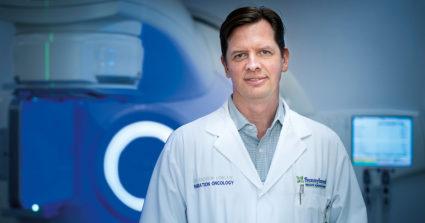Phil Dubois knew he had to do some digging before deciding on what treatment path to choose after hearing his diagnosis of prostate cancer.
The active 61-year-old was referred to a surgeon straight away. While surgery to remove the cancer was an option, Phil wanted to do more research and spoke to friends and family. Phil’s sister connected him with a friend who had just received radiation treatment from Dr. Andrew Loblaw, a radiation oncologist at Sunnybrook.
“I wanted to hear about the side effects, the probability of getting rid of all the cancer, and the risk of recurrence,” Phil says. “Being referred to Dr. Loblaw opened a whole new path and provided a realistic alternative to surgery. I was amazed and impressed at the extent of his knowledge and commitment, not only to curing the disease but to also ensuring the best possible quality of life for each and every patient.”
Dr. Loblaw told Phil about a new trial — EARTH — that was combining one session of brachytherapy and one session of stereotactic ablative body radiotherapy (SABR). Brachytherapy involves delivering a high-dose of radiation internally, right to the prostate. SABR is a high-precision, external beam radiation treatment.
In August, Phil became the first patient treated in the EARTH trial. Being first didn’t rattle Phil.
“There was comfort in knowing that both of these methods have been used for a long time, they are just combining them in a different way,” Phil says. “I have heard that previously, radiation for prostate might be 5 or even up to 39 sessions. When I learned the EARTH trial was an option for me, I went for it. Having to come in for two treatments, along with some tests, sounded appealing and convenient to me.”
Dr. Loblaw says the idea of combining one SABR and one brachytherapy came after several studies looked at the effectiveness of each separately.
“We did a lot of work investigating the use of 5 SABRs versus 2 SABRs — and two was just as effective,” he explains. “And brachytherapy is a critical piece in the approach to prostate cancer treatment. So we decided to look at the best of both worlds and combine one SABR and one brachytherapy.”

Dr. Andrew Loblaw, radiation oncologist.
During the EARTH trial, patients will undergo extensive imaging to measure how much of the tumour cells died after the first treatment.
“We will be using molecular imaging via MRI sequencing in real time and doing biopsy, collecting bloods and urines — every possible measure,” Dr. Loblaw says. “We will collect all this data and it will allow us to later develop different approaches based how much cell kill we get after the first treatment — higher dose brachytherapy or lower dose brachytherapy, or a combination of medications.”
So, while treatments are currently based on the grade of prostate cancer, this trial will allow further customization and personalization.
“We will later be able to adapt based on the tumour’s response to treatment,” Dr. Loblaw says. “That’s really exciting in the world of prostate cancer radiation; I believe it’s the first time anyone has done this.”
The best part of treatment, so far, Phil says, is that he has had very few side effects.
“I feel just like myself. I am eating, I’m sleeping, I’m exercising. I feel really good.”
While radiation or a new trial might not be an option for everyone, Phil encourages others facing prostate cancer to seek multiple opinions and information from a variety of sources.
“The first reaction is panic and the desire to deal with it right away to ‘get it out of my body’,” Phil says. “There is a lot of differing study results and data on recurrence, side effects and successes, so talk to people, find out as much as you can so you can decide what’s best for you.”








